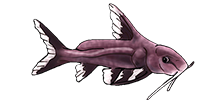https://sciendo.com/article/10.26881/oahs-2023.4.03
Key words: Ostariophysi, fins, anatomy, growth and differentiation, taxonomic identificationAbstract
The anatomy, growth, and differentiation of the dorsal fin spines of three catfish species collected from the Nile River and Lake Nasser. Egyptian waters are described, and terminology is suggested for their parts. Features of the dorsal fin spine that change with growth are also described. The results showed that in all species studied, the dorsal spine is an elongate, compressed, tapered, slightly arched, osseous structure, bearing a series of retrorse dentations along the anterior and posterior surfaces and has a sharp sagittate tip. The retrorse, anterior dentations are most pronounced in the upper third of the spine and gradually alter in form until they appear as a series of distinct notches on the basal third of the spine. The anterolateral surfaces of the dorsal spine are marked by numerous short, irregular, shallow, anastomosing, longitudinal furrows. In three species (C. auratus, S. schall, S. serratus), the posterior process is poorly developed and directed laterally in young individuals and well produced and directed posteriorly in older specimens. In S. schall and S. serratus, the posterior blocking process of the large specimens has a wavy edge, while in S. serratus, it is curved in young individuals and straight in larger specimens.




